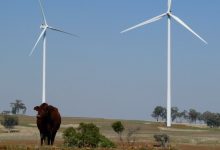The ACT government has taken steps to re-affirm its commitment to maintaining its 100% renewable electricity target in perpetuity, at the same as the territory locks-in a feed-in tariff rate for its first community solar farm.
SolarShare, which will build a 1MW solar farm in the ACT suburb of Majura, has secured an agreement to sell electricity to the ACT government for $195.60 per MWh, in what is set to be Australia’s largest community-owned solar farm.
SolarShare’s community ownership model, which offers shares in the solar farm to members of the public, recently succeeded in securing full funding for the project, raising a total of $2.36 million in community investment. Shareholders will receive a dividend from revenues received by the project, with Solar Share aiming to deliver a return of between 4 and 6 per cent for investors.
Renewable energy project developer CWP Renewables stepped in to provide an $800,000 loan to the project, bridging a finance gap and allowing the project to proceed to construction, after SolarShare secured an EPC contract with commercial solar developer Epho late last year.
Works at the Majura site are expected to commence before the end of the year and will be co-located to the 2.3MW Majura Solar Farm owned by Impact Investment Group.
While the payment is likely to be viewed as receiving a premium over purely commercial projects, SolarShare hopes the project will be the first of many community solar projects, intending the Majura community solar farm to serve as a model to be replicated.
The ACT government’s confirmation of the feed-in tariff to be paid to the SolarShare project comes as it amends its legislated targets to ensure that the Territory remains 100 per cent powered by renewables after 2020.
In legislation that passed through the ACT Legislative Assembly in May, an amendment ensured that a “target for the use of renewable electricity in the ACT is 100% on and from 1 January 2020.”
The amendments require the ACT energy minister to monitor the level of renewable electricity purchased by the ACT, and to make arrangements for the purchase of additional renewable electricity should electricity demand grow, or supply from existing projects drops off.
“In passing the legislation embedding 100% in perpetuity there is a recognition that future auctions (or other approaches to securing renewable energy) are likely to be needed.” Rattenbury told RenewEconomy.
“This is because of population and economic growth, the electrification of transport, and the shift from gas. In the shorter term, we will also need to monitor actual output from our existing contracted generators relative to expected. The last of these generators will come online for the ACT in October, and we will meet the 100% target from 2020.”

This raises the potential for the ACT to undertake further reverse auctions for the purchase of additional renewable electricity in the future, to maintain its level of 100% renewable electricity in light of changing consumption.
The ACT sees the electrification of public transport, shifting the diesel-fuelled bus network onto electric alternatives that can be powered by 100 renewable electricity, as an effective means of reducing emissions.
The territory recently saw a successful launch of the territory’s first light rail service, with a 12km first-stage running between Canberra’s CBD and the northern Gungahlin town centre. The all-electric light-rail system is another step towards the electrification of the ACT’s public transport system, which has also undertaken trials of all-electric buses as part of its bus fleet.
The ACT is also considering setting targets for the use of renewable energy outside of the electricity sector, as the Territory moves towards achieving its target of zero net emissions by 2045. By shifting all of its electricity use to renewable energy, the ACT has been able to reduce its greenhouse emissions by around 40 per cent.
However, to achieve further reductions, emissions reductions will need to be achieved in other sectors, including transport, waste, and displacing emissions from gas use within the ACT. The ACT energy minister has the ability under the amended legislation to set dedicated renewables targets for non-electricity energy use.
Amendments made to the ACT’s legislated targets also provide the ACT energy minister with the ability to determine targets for the use and generation of “renewable energy for the ACT other than electricity”.
“At this point [non-electricity targets] is essentially covered by the ‘zero net emissions by 2045’ target we’ve legislated. To reach this target, we’ll need to transition away from gas and address transport fuels. The government is increasingly taking steps in this direction.” Rattenbury said.
“For example, with our first ‘electric school’ now open, and the funding in the recent ACT Budget for two new schools to become all electric; Ginninderry is progressing with its first 1,100 residential dwellings not connected to gas; the ACT Government offices being constructed at Dickson will be the ACT government’s first zero emissions office building.”
The ACT will achieve its target of generating 100% of its electricity from renewable sources when Stage 3 of the Hornsdale Wind Farm being supplying the ACT with electricity from October.
Other projects contracted to the ACT, which include the Ararat, Sapphire and Coonooer Bridge wind farms, may also get pinged by recent changes to marginal loss factors (MLFs) by AEMO, which have significantly impacted many renewable energy projects across the National Energy Market.
Energy analyst David Osmond provided a review of the data covering renewable generation to date that has been supplied to the ACT under power purchase agreements, showing that contracted projects would have supplied equivalent of 98% the ACT’s consumption over the last seven months, including up to 78% of the ACT’s real-time energy consumption, without the need for storage.








